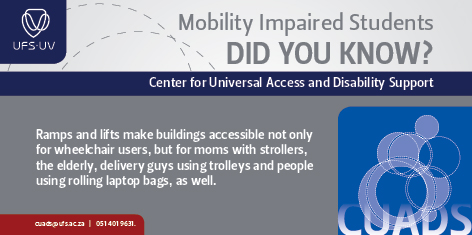
Centre for Universal Access and Disability Support’s logo for persons with mobility impairments.
Design: Karoo Republic
Hi, my name is Jackson, and I am a wheelchair user following an accident that left me paralysed.
We often take for granted the ability to navigate obstacles, and to move readily from place to place. Few people have to worry about mobility on campus, but for students with mobility impairments, it presents many challenges that few of us are aware of.
The biggest struggle for students with mobility impairments is often encountered in the lecture room/hall. Once they arrive at the class (often struggling to get there on time), their next challenge might be entering the classroom and finding a suitable place where they can sit comfortably. As it is, there are only a few loose tables in most lecture halls. Consequently, the students have to sit through the lecture taking notes and working with their laptops resting on their laps. Obviously, this is uncomfortable and not conducive to their learning process.
When students have limited hand function, the result is that they write more slowly and with difficulty. However, the UFS does offer assistance from scribes, adapted computer hardware/software, assistive devices, and/or modified furniture. Such adaptations can be arranged by the Centre for Universal Access and Disability Support (CUADS), which boasts an official test and examination venue where students with mobility impairments can proceed with their tests and exams if they prefer.
Students with Cerebral Palsy may experience difficulties with quick, sudden physical movements, and delayed processing of information. Stressful circumstances can result in their experiencing difficulty when having to write or process information quickly enough during test and examination situations. The Extra Time Panel, in collaboration with Student Counselling and Development, determines the time concession for those students with mobility impairments who have such needs.
The importance of accessible parking spaces exclusively designated for wheelchair users not only involves such places being closer to a building entrance but also wide enough for a wheelchair user to get in and out of a vehicle safely.
?